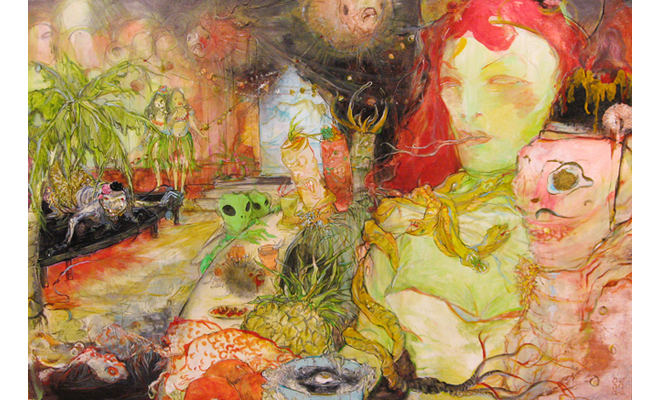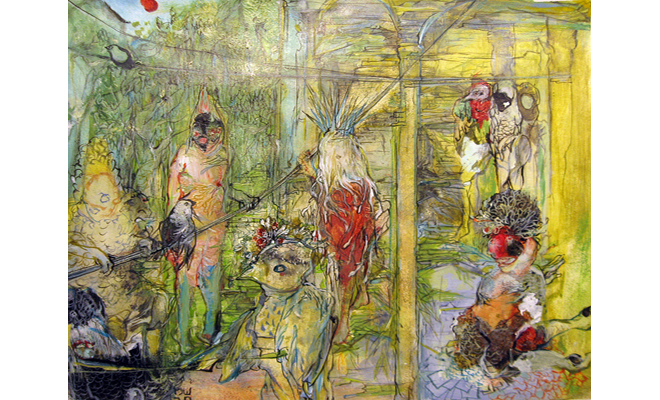Otherworld: The Dreamscapes of Myrtle von Damitz

Myrtle von Damitz, Lou Lou’s Tiki Lounge, 2011. Inks and acrylic on board. Courtesy the artist.
Myrtle von Damitz
Barrister’s Gallery
2331 St. Claude Avenue
November 10–December 3, 2012
The point is to be unsure. We travel through their landscapes, searching for referents, casting about for the familiar. Rarely do we find it, but when we do, we find it to have changed in ways we cannot fully comprehend: an astronaut reclines in a shopping cart or a horse has grown six legs. Yet it still makes a certain form of sense, in the paradoxical way that dreams do.
Born in Syracuse, New York, Myrtle von Damitz is a self-taught painter, a training (or lack thereof) that has served her well: earlier this year the Oxford American named her one of its “100 under 100: The New Superstars of Southern Art,” one of only a handful of artists selected in the city. An admitted wanderer, she has lived primarily in New Orleans for the past 13 years, though nowadays she calls Cottage Grove, Oregon home. Within New Orleans, she’s earned a committed following through the annual Babylon Lexicon exhibition, a celebration of book arts she founded in 1999. Her work appears at Barrister’s Gallery, including in the upcoming “Volatilia,” a group show she curated as an offshoot of the Automata mechanical sculpture collective, which she also founded in 2010.
As befits a dream, von Damitz’s work is characterized by strange and ethereal landscapes, loose and unassociated objects, and curious figures who would not be out of place in a Dorothea Tanning painting. Executed usually in a mix of pen, ink, and acrylic, her paintings are viscous and lush, saturated with colors that melt into and out of one another, creating a blurred, almost gauzy effect. Von Damitz claims that textures on the canvas are merely “an important accident,” yet their richness suggests otherwise—with streaks and splotches accentuating critical moments in the works. Though her palette frequently involves contrasting colors—pinks against blues, or greens against reds—the reigning surreality of the composition lends these clashes a kind of perverse logic. One would not expect a dream world to look like our own, whether in its figures or its setting.
On to those figures: they range from the anthropic to the animal, to hybrid half-forms caught somewhere in between. Many of them look as though they crawled, or lurched, straight out of a Hollywood studio creature shop. Others resemble known paranormal forms such as the Grey aliens of Roswell lore, depicted in a work like Lou Lou’s Tiki Lounge, 2011, bellying up to a bar alongside three irate carrots, themselves watched nervously by two hula girls (one upon closer inspection a skeleton), and an obese feral humanoid who has collapsed upon the stage, microphone still in claw. This sort of weird and intricate tableaux, as though David Lynch had reshot the scene of the Mos Eisley Cantina from Star Wars, is not uncommon in a von Damitz composition. In fact, it might even be said to be the norm.

Myrtle von Damitz, Handbasket, 2011. Inks and acrylic on paper. Courtesy the artist.
Many of von Damitz’s figures are engaged in activities that we would recognize—eating, drinking, socializing, commuting, and promenading—but crucially, others are depicted in those that we would not. The figures that stand around, waiting—but for what? —such as in the eerie Handbasket, 2011, are unnerving precisely because it is impossible to determine their origin, function, or trajectory. As in a dream, they are simply there: begging both explanation and explication but inviting instead only unease.
Birds feature regularly in her work, whether as main characters, supporting actors, or even just as spectators, nesting in the trees. Frequently they are the loci of violence: in I Will Have the Keepon In the Car For You, 2012, small chicks that strongly resemble the celebrated Peeps Easter candies parachute into an ill-defined war zone, populated by ravenous bloody horned monsters who seek, it appears, only to consume them. Elsewhere, Biddie Bird Biddie, 2010, depicts a walking parade of four different species, including a rooster-like creature bearing a mallet (or maybe it’s an ax). Von Damitz has said that her figures are not intended to be “faddish” grotesques, but rather she is aiming to sever the concept of these figures from their referents: in her words, “to separate your sense of what something is supposed to mean from what the painting is about, or might be.”
By reflecting on our dreams, we learn how to observe and appreciate waking life, even as waking life offers us the raw material from which our dreams are woven. So we may wonder: with the violence that figures so prominently in her work—hungry skulls, severed bodies, subjugations and imprisonments, jailors whose own flesh has been flayed as in an early anatomist’s écorché—where does this profusion come from, and what purpose does it serve? Viewers can only speculate. But one thing is true nonetheless: if this is what she makes visible of her imagination, we may take comfort in the fact that what she has chosen to depict of her dreams, she has spared us what remains. Her nightmares.



